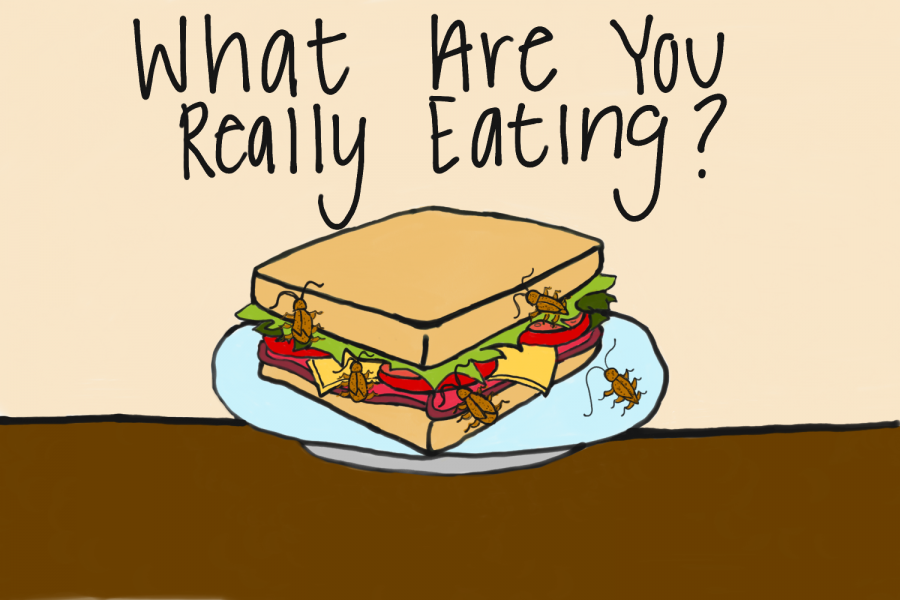What are you really eating?
The FDA allows a certain amount of insect fragments in food
Photo by Makenzie Hofert
Graphic by Makenzie Hofert depicting the insects commonly found in food, unbeknownst to consumers.
December 11, 2019
As soon as you get home from school, you go to the kitchen and grab a box of cereal to make an afternoon snack, but what are you really eating? Insect fragments, maggots, rodent hair and possibly fecal matter. Many people are unaware of what accidently gets mixed in with our food in the factories, such as bugs.
The average human consumes more insects than they would want to believe. According to Reader’s Digest, people usually eat about two pounds total of different insect fragments each year which is considered normal. Consuming these critters have no harmful effects on the human body.
The limit to what’s actually in our food tends to have quite a wide range of options. Some of the critters you may be consuming consist of flies, maggots, cockroaches, mites or mealworms. Sick to your stomach yet? Well, that’s not the end to the list of repulsive add-ins that are within our food. The rodent hair and rodents’ feces is what ices the cake. The FDA makes sure to keep a close watch on what exactly is put into our food and the quantity or else certain foods would be banned from the local grocery stores.
“Coming from a production standpoint, and knowing how the food industry works this isn’t surprising because when you have a large manufacturing company that produces box goods and processed food, you’re going to have [bug fragments in your food],” Culinary Arts teacher Cory House said. “There’s no way that you can control every microscopic thing that goes into food.”
Everything you buy that is deemed edible has some degree of insect parts or fecal matter inside of it, as claimed by Reader’s Digest. For instance, peanut butter can have over 120 insect fragments before it is classified as contaminated or corrupted, even if the placement of the bugs is accidental.
Chocolate, on the other hand, tends to contain more insect fragments than many other sweets on the market. There are approximately 70 insect pieces found in average sized chocolate bar purchased at your local gas station. If you ate a chocolate bar once a week, that’s about 4,000 bug fragments added to your yearly diet, aside the insects in your other food. Let that sink in for a moment.
Another example would include pastas. Most pasta contains an estimated 225 pieces of insects per 225 grams. So every bite you take, you better be enjoying your bug bits. The reasoning behind the FDA allowing so many insect parts in pastas compared to others is due to the way the insects crawl in there in the first place. The insects that will more than likely be in your pasta are mealworms, maggots and roaches, and they simply get to the pasta through the wheat when it is still within the factories. The bugs have time to set and spread many germs within the food since the wheat sits in the factories for a couple of days.
The list continues on, from coffee beans to raisins to mushrooms. Each thing you consume by mouth has something within it you’d rather not think about eating, even dairy related products.
As stated by Business Insider, the strawberry and cherry flavored yogurts get their special red color from dye. What they lacked in telling you was that the dye was carmine which is a natural dye that derives from the cochineal bug once it’s crushed up. Have fun digesting that information. Even though the back of the yogurt cup contains the ingredients, it’s highly doubtful you read over “carmine” in the list and realized what it was.
The vegan community opposed the idea of using these bugs as a natural dye in yogurt. In fact, Yoplait is one of the few yogurt companies that still uses the crushed cochineal bugs but hey, maybe that’s where the flavor comes in. Dannon is also a strong believer in the use of carmine. They use it for many flavors outside the realm of strawberry and cherry such as, boysenberry and raspberry.
According to the Center for Science in the Public Interest, the carmine dye can cause possible allergic reactions while the plant based dyes don’t have the same effect. Carmine isn’t only within your favorite yogurts, though. You can also find lovely remnants of this bug in candies, ice cream and even cosmetics.
“When you have food that’s being processed, there are going to be things that end up in it that you won’t know about,” House said. “And that’s why companies [sometimes] have to end up recalling goods because metal fragments from machinery malfunctioning gets into the food, plastic gets in it, and so insect fragments are just the nature of the business, which is horrible because you expect the food you buy to be 100% pure, but that’s definitely not the case.”
Although the bugs in our food may sound like a huge ordeal for certain people, Chef House seems to disagree on certain complaints.
“It’s crazy to think the FDA can’t shut down a chicken plant for testing positive in certain bacterial strains, but if they found roaches they could,” House said. “So I feel like there are safeguards to protect us from bug fragments, but there’s things that are a bigger concern than bug fragments.”














